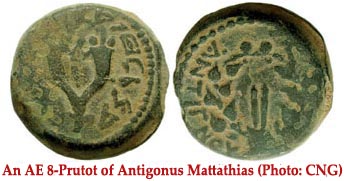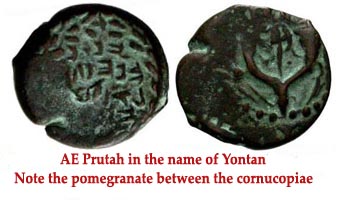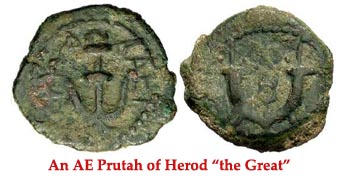| |
|
|
|
|
The cornucopia served as a Jewish symbol By: David Hendin |
|
|
|
|
| |
|
| |
|
Recently a few readers have inquired about how the cornucopia became a symbol commonly used on ancient Jewish coins. In fact, the cornucopia was one of the most popular religious symbols of the ancient world.
It came into use on the coins of the Hasmonean (or Maccabean) kings, and later on the coins of Herod the Great and his son Herod Archelaus via Hellenistic influence. Coins of the Ptolemaic Kings of Egypt, Seleucid Kings of Syria, as well as a number of ancient Hellenistic city-states depicted cornucopiae.
In a hard-to-find 1976 article in The Judaica Post, Ya’akov Meshorer |
 |
explains that “During the Hellenistic period, and in particular during the third to first centuries B.C.E., Greek culture spread all over the ancient world. Its influence resulted in the Hellenization of the Oriental countries and nations. We can confidently say that during this period, all cultures of the Near East were influenced by the Greek culture. This does not mean that these peoples changed their religions or customs entirely. They simply adopted some of the new elements and produced a combination of eastern and western religions; this phenomenon is known as syncretism. Sometimes an Oriental cult kept its entire meaning and content, and changed only its name or shape of god. The same process occurred with respect to certain symbols which, although adopted from the Greeks by an Oriental religion, retained an independent Oriental significance.”
Basically, the cornucopia was an animal horn, hollow, and thus used as a container for many purposes. As the overflowing “horn of plenty”, it contained agricultural fertility symbols such as ears of grain, bunches of grapes, and pomegranates. On Hellenistic coins the cornucopia is often carried by Tyche, the city goddess, or Demeter, the goddess of the earth.
Paul Romanoff writes that “The cornucopiae appearing alone, without the goddesses…were abstract symbols. In this respect the horns of plenty were akin to Jewish symbols.”
In Ancient Jewish Coinage, Meshorer adds that “It is logical to assume that the symbol filtered into Judaism as an object related to fertility, and then acquired additional Jewish connotations…In Jewish life animal horns were used for a number of purposes, including as an oil container, an object to anoint kings, or as ‘shofars’-musical instruments of the temple service.”
The use of the animal horn as a hold for oil is referred to in the first Book of Samuel (16:13) during the coronation of King David: “Then Samuel took the horn of oil and anointed him in the midst of his brethren.”
Possibly the horn of plenty became a symbol for the ancient Jews because of the legendary richness of the ancient Holy Land itself-the very land of milk and honey. We know, for example, that cornucopiae were used by the Jews in the Holy Land in the first few centuries C.E. not only on coins, but on other small objects such as seals, rings, amulets, and also in larger architectural contexts. A famous relief of a double cornucopia with a pomegranate between was found in the excavations of the Jewish Quarter of the Old City of Jerusalem and can be seen in The Israel Museum. It dates from the first century B.C.E. to the first century C.E.
|
|
On the coins of the earlier Hasmonean kings-Yehohanan, Yehudah, Yehonatan, and Yonatan-the double cornucopia also appears with the pomegranate between the horns. Occasionally the pomegranate has a different appearance, and some numismatists have described it as a poppy flower. But at this point I have seen enough examples where the design is very clearly a pomegranate, and we can say that variations from that specific motif are mainly due to the differing styles of the artisans who cut the coin dies.
Antigonus Mattathias (Mattatyah), the last Hasmonean king (40-37 B.C.E.), struck larger denomination coins with a double cornucopia and nothing between, coins with a single cornucopia,
|
 |
and also coins with a double cornucopia containing an ear of barley (often referred to as an “ear of corn”, meaning, in fact, “barley-corn”) between the horns.
A variation of this design that appears on many small objects, but not on coins, shows a lily flower between the horns. Apparently this combination appears only on Jewish art.
During the period of Herod the Great, Meshorer writes, the cornucopia “seems to lose its Jewish nature; it was used in a different fashion by Herod the Great and his son Herod Archelaus, who replaced the pomegranates and ears of barley by a caduceus, a clearly pagan symbol.”
|
 |
Herod apparently took great care that the symbols on his coins would not seem to be either too Jewish or too pagan, reflecting his attempts to bridge the two cultures with his own reign. Remember that Herod was a client of Rome and had taken over by force from the popular Hasmonean dynasty. What better reasons for him to try to toe the line between cultures. In this case the cornucopiae represent a Jewish element, and the caduceus, a pagan element.
After the time of Herod the Great the cornucopiae show up only a couple of times as symbols clearly intended to acknowledge local Jewish populations. City coins of Sepphoris (under Nero), Tiberias (under Trajan), and Neapolis (under Domitian) depict cornucopiae
|
 |
as their singular reverse motifs.
|
| |
First published in The Celator, January 1993; reproduced by permission of the author
|
| |
|
|
|
|
|